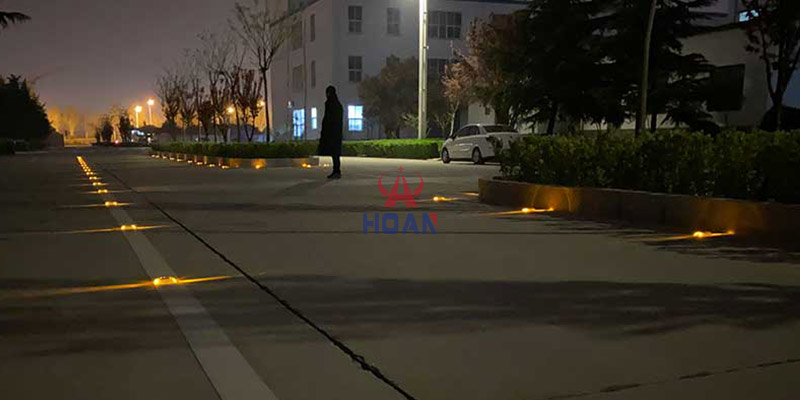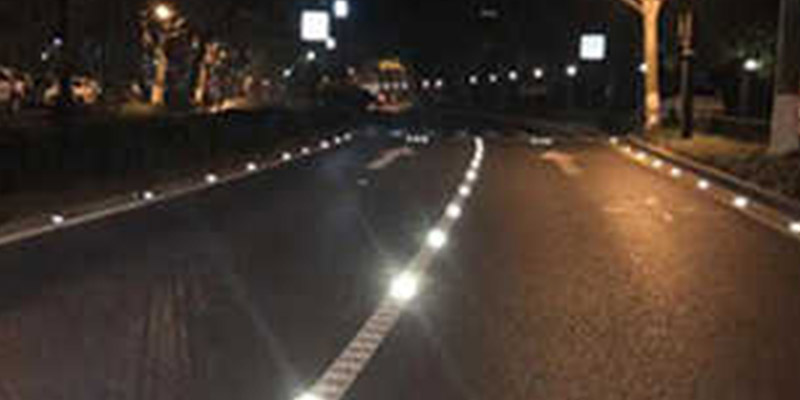Community roads are not merely “small streets” but serve both “residential functions” and “transportation needs”: During morning and evening rush hours, they see electric bikes picking up children, elderly residents shopping for groceries, and neighbors taking strolls. Though speeds are low, the mix of pedestrians creates complex traffic patterns. Nighttime lighting often creates blind spots due to tree obstructions, and traditional reflective markings are easily obscured by fallen leaves, posing significant safety hazards.
Compared to high-brightness solar studs used on highways, community-specific models prioritize “gentle warning” and “pedestrian-friendliness.” They avoid glaring light that disturbs residents' rest while guiding vehicles to yield to pedestrians through clear light bands. By filling streetlight blind spots, they become the “invisible guardians” of community road safety.
(1) Operational Characteristics: Continuous low-intensity illumination for gentle alerts
Utilizing 300-500mcd low-brightness LEDs, these studs emit sustained warm white or yellow light at night without glare. Their hue harmonizes with community streetlights, preventing bright nighttime illumination from disturbing residents in lower-level dwellings.
(2) Suitable Community Scenarios
Residential Main Roads (Two-Way, Two Lanes): Installed along lane edges to form continuous light strips, helping drivers identify lane boundaries and prevent lane-crossing collisions.
Residential Pathways:
Marking curbs on 1.5-2m-wide pedestrian paths with constant-on studs to prevent seniors and children from tripping.
(3) Core Advantages
Stable illumination requires no frequent mode switching, minimizing maintenance costs. Ideal for community roads with stable traffic and pedestrian flow.
(1) Operational Features: Smart Triggering, Energy-Efficient
Built-in human/vehicle sensors (3-5m detection range). Maintains low-intensity constant illumination when no movement is detected. Automatically switches to slow flashing mode (1 flash/second) upon detecting pedestrians, e-bikes, or cars approaching, alerting both parties to yield.
(2) Community Applications
Community Entrances/Exits: Key junctions connecting to municipal roads with frequent vehicle traffic. Flashing mode alerts incoming vehicles to “slow down when entering the community.”
Roads Near Children's Play Areas: During evening playtimes, the studs automatically flash upon detecting crowds, warning passing vehicles to “yield with caution.”
(3) Core Advantages
Eliminates issues of “constant power drain” and “ineffective without warning,” particularly suited for community areas with intermittent pedestrian and vehicle traffic.

(1) Material Properties
Lightweight (50-80g per unit), highly weather-resistant (-30°C to 60°C). Surface colors (gray, brown) can be customized to match community paving tiles, ensuring high road surface integration and low visibility to pedestrians after installation.
(2) Suitable Community Scenarios
Newly constructed asphalt/concrete roads: Installed with epoxy adhesive in 10 minutes without damaging pavement;
Temporary road sections (e.g., post-construction restoration): Removable and reusable, reducing renovation costs.
(3) Precautions
Load capacity: Approximately 5 tons. Suitable for small cars and electric vehicles within communities. Not recommended for fire lanes or areas with frequent heavy vehicle traffic.
(1) Material Properties
Shell thickness: 1.5-2mm. Withstands loads up to 10 tons, resistant to crushing and corrosion. Sandblasted surface finish provides slip resistance coefficient ≥0.8, preventing slips during rainy weather.
(2) Community Applications
Community fire lanes: Withstands heavy vehicles like fire trucks and ambulances; aluminum alloy prevents deformation.
Gravel/brick roads in older communities: Uneven surfaces; the high strength of the aluminum alloy shell adapts to complex road conditions and resists damage.
(3) Core Advantages
Service life of 8-10 years, 3-5 years longer than plastic models, reducing replacement costs over time. Ideal for established communities planning long-term use.
(1) Installation Requirements
Main roads 4-6 meters wide (two lanes each way) require guiding vehicles to stay within lanes, preventing nighttime lane crossings due to poor visibility, while reminding pedestrians to “walk on the side.”
(2) Marker Selection & Layout
Type: Constant-on ABS plastic markers (warm white), 400mcd brightness;
Layout: Install one marker every 1.5-2 meters along both edges of the lane, forming two parallel light bands. Leave the center unmarked (to avoid obstructing pedestrians crossing).
(3) Actual Results
After implementation in a Beijing community, nighttime fender-benders on main roads dropped from 2 per month to zero. Residents reported, “Driving at night, we can clearly see the road edges and no longer fear hitting pedestrians.”
(1) Installation Requirements
At T-junctions and crossroads within communities lacking traffic signals, where pedestrians, e-bikes, and cars intersect, “sudden appearance” accidents are common, necessitating advance warnings.
(2) Stud Selection and Layout
Selection: Sensing-flashing aluminum alloy studs (yellow), with a sensing range of 5 meters;
Layout: Install one stud every meter within a 10-meter radius around the intersection, forming a “square warning zone.” Studs automatically flash when vehicles or pedestrians enter the zone.
(3) Actual Results
After installation at a Shanghai community intersection, conflicts between pedestrians and vehicles during morning and evening rush hours dropped from 5-6 incidents daily to fewer than 1 incident. Elderly residents now safely escort children to and from school.
(1) Installation Requirements
Some community roads feature “mixed traffic” where electric bikes and pedestrians compete for space, leading to frequent scrapes. Studs are needed to clearly delineate separate travel zones.
(2) Marker Selection and Layout
Selection: Low-profile (≤8mm) permanently illuminated plastic markers (white) to prevent tripping pedestrians.
Layout: Install one marker every 1 meter along the boundary line between sidewalks and bicycle lanes, forming an “invisible dividing line” to remind e-bikes not to cross the line.
Community roads differ from highways and do not require high-brightness studs exceeding 1000mcd. Select low-brightness models (300-500mcd) with warm white or yellow light to prevent strong light from shining directly into residents' windows at night and causing complaints.
On sidewalks or mixed-use pedestrian/vehicle areas, stud height must ≤8mm with anti-slip texture (coefficient of friction ≥0.8). This prevents trips for seniors and children, especially during rainy weather when slippage is a risk.
Stud colors should be customizable to match pavement or paving stone tones (e.g., gray, brown). Installation should aim for flush alignment with the surface to prevent protrusions that compromise the overall aesthetic of community roads—a critical consideration for villa complexes and high-end communities.

(1) Community Challenges
Built 20 years ago, the main road's asphalt surface had deteriorated, lane markings faded, and streetlights were obscured by plane trees at night, creating numerous blind spots. Elderly residents avoided going out after dark.
(2) Stud Selection and Installation
Type: Constant-on ABS plastic studs (warm white, 400mcd);
Installation: Mounted along both edges of the main road at 2-meter intervals, totaling 80 units. Cost: approximately ¥4,000.
(3) Transformation Outcomes
Nighttime visibility on the main road improved by 80%. Elderly nighttime mobility increased from 30% to 60% post-renovation. No complaints received regarding glare disturbance.
(1) Community Requirements
Create a “Smart Safety Community” where roadways integrate safety guidance with landscape design, avoiding traditional road studs that compromise pavement aesthetics.
(2) Stud Selection and Installation
Selection: Motion-activated flashing aluminum alloy studs (custom gray to match paving tiles, 500mcd);
Installation: Main roads use constant-on mode; intersections use sensor-activated flashing mode. Total of 150 units installed, flush-mounted into pavement.
(3) Renovation Outcomes
Became the community's “invisible safety feature”—eliminating glare disturbances while effectively reducing pedestrian-vehicle conflicts. Resident satisfaction reached 95%.
Community road safety lies in every detail. When selecting solar road studs, prioritize “best fit” over “most expensive”—match the lighting mode, material, and installation method to your community's road width, pedestrian/vehicle traffic patterns, and landscape requirements. This approach solves major safety issues at minimal cost.
If you're selecting solar road studs for community road upgrades, contact us with your community road layout plan. We'll provide a free customized selection plan, complete with a 3-year warranty and installation guidance, ensuring every road in your community becomes a safe “path home.”